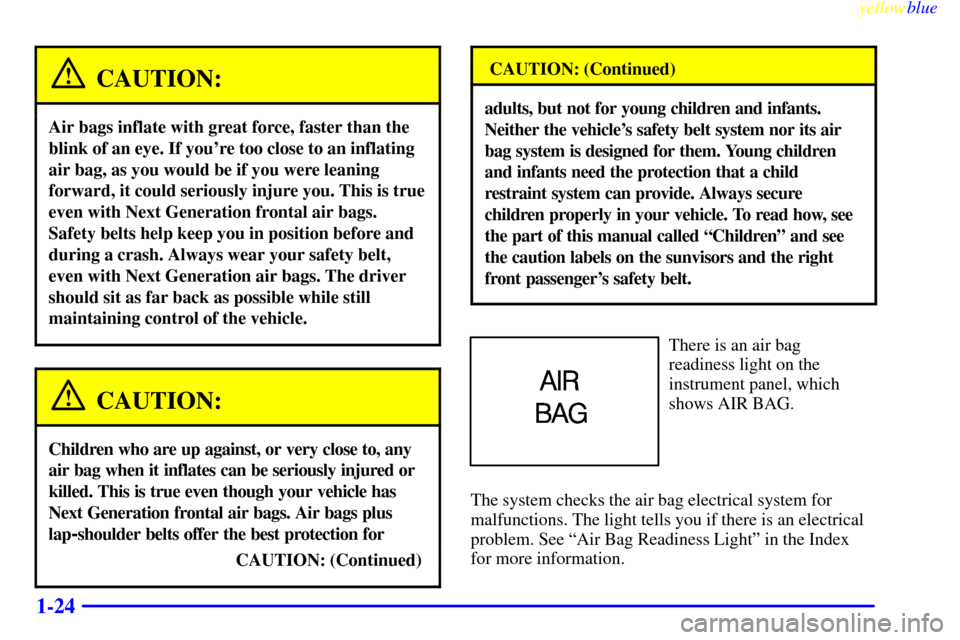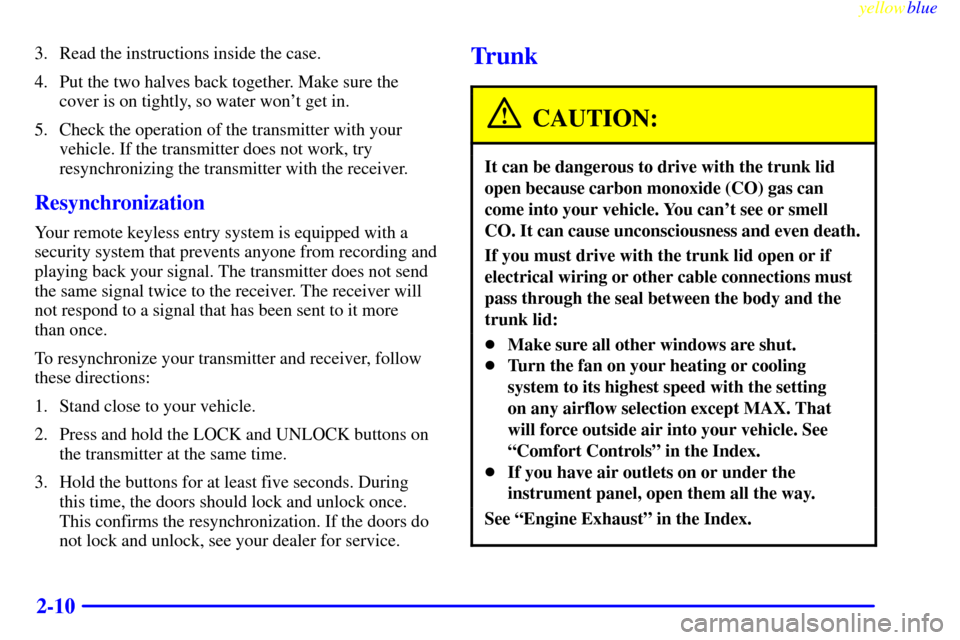Page 19 of 368
yellowblue
1-11
The person keeps going until stopped by something.
In a real vehicle, it could be the windshield ...or the instrument panel ...
Page 32 of 368

yellowblue
1-24
CAUTION:
Air bags inflate with great force, faster than the
blink of an eye. If you're too close to an inflating
air bag, as you would be if you were leaning
forward, it could seriously injure you. This is true
even with Next Generation frontal air bags.
Safety belts help keep you in position before and
during a crash. Always wear your safety belt,
even with Next Generation air bags. The driver
should sit as far back as possible while still
maintaining control of the vehicle.
CAUTION:
Children who are up against, or very close to, any
air bag when it inflates can be seriously injured or
killed. This is true even though your vehicle has
Next Generation frontal air bags. Air bags plus
lap
-shoulder belts offer the best protection for
CAUTION: (Continued)
CAUTION: (Continued)
adults, but not for young children and infants.
Neither the vehicle's safety belt system nor its air
bag system is designed for them. Young children
and infants need the protection that a child
restraint system can provide. Always secure
children properly in your vehicle. To read how, see
the part of this manual called ªChildrenº and see
the caution labels on the sunvisors and the right
front passenger's safety belt.
There is an air bag
readiness light on the
instrument panel, which
shows AIR BAG.
The system checks the air bag electrical system for
malfunctions. The light tells you if there is an electrical
problem. See ªAir Bag Readiness Lightº in the Index
for more information.
Page 33 of 368
yellowblue
1-25 How the Air Bag System Works
Where are the air bags?
The driver's air bag is in the middle of the
steering wheel.
The right front passenger's air bag is in the instrument
panel on the passenger's side.
Page 35 of 368

yellowblue
1-27
What makes an air bag inflate?
In an impact of sufficient severity, the air bag sensing
system detects that the vehicle is in a crash. The sensing
system triggers a release of gas from the inflator, which
inflates the air bag. The inflator, air bag and related
hardware are all part of the air bag modules inside the
steering wheel and in the instrument panel in front of the
right front passenger.
How does an air bag restrain?
In moderate to severe frontal or near
-frontal collisions,
even belted occupants can contact the steering wheel or the
instrument panel. Air bags supplement the protection
provided by safety belts. Air bags distribute the force of
the impact more evenly over the occupant's upper body,
stopping the occupant more gradually. But air bags would
not help you in many types of collisions, including
rollovers, rear impacts and side impacts, primarily because
an occupant's motion is not toward those air bags. Air
bags should never be regarded as anything more than a
supplement to safety belts, and then only in moderate to
severe frontal or near
-frontal collisions.What will you see after an air bag inflates?
After an air bag inflates, it quickly deflates, so quickly
that some people may not even realize the air bag
inflated. Some components of the air bag module
-- the
steering wheel hub for the driver's air bag, or the
instrument panel for the right front passenger's bag
--
will be hot for a short time. The parts of the bag that
come into contact with you may be warm, but not too
hot to touch. There will be some smoke and dust coming
from vents in the deflated air bags. Air bag inflation
doesn't prevent the driver from seeing or from being
able to steer the vehicle, nor does it stop people from
leaving the vehicle.
Page 36 of 368

yellowblue
1-28
CAUTION:
When an air bag inflates, there is dust in the air.
This dust could cause breathing problems for
people with a history of asthma or other
breathing trouble. To avoid this, everyone in the
vehicle should get out as soon as it is safe to do so.
If you have breathing problems but can't get out
of the vehicle after an air bag inflates, then get
fresh air by opening a window or door.
In many crashes severe enough to inflate an air bag,
windshields are broken by vehicle deformation.
Additional windshield breakage may also occur from the
right front passenger air bag.
�Air bags are designed to inflate only once. After they
inflate, you'll need some new parts for your air bag
system. If you don't get them, the air bag system
won't be there to help protect you in another crash.
A new system will include air bag modules and
possibly other parts. The service manual for your
vehicle covers the need to replace other parts.�Your vehicle is equipped with a crash sensing
and diagnostic module, which records information
about the air bag system. The module records
information about the readiness of the system,
when the sensors are activated and driver's safety
belt usage at deployment.
�Let only qualified technicians work on your air
bag system. Improper service can mean that your
air bag system won't work properly. See your dealer
for service.
NOTICE:
If you damage the covering for the driver's or the
right front passenger's air bag, the bag may not
work properly. You may have to replace the air
bag module in the steering wheel or both the air
bag module and the instrument panel for the
right front passenger's air bag. Do not open or
break the air bag coverings.
Page 65 of 368

2-
yellowblue
2-1
Section 2 Features and Controls
Here you can learn about the many standard and optional features on your vehicle, and information on starting,
shifting and braking. Also explained are the instrument panel and the warning systems that tell you if everything is
working properly
-- and what to do if you have a problem.
2
-2 Keys
2
-4 Door Locks
2
-6 Remote Keyless Entry (If Equipped)
2
-11 Theft
2
-12 Passlock�
2-13 New Vehicle ªBreak-Inº
2
-13 Ignition Positions
2
-16 Starting Your Engine
2
-18 Engine Coolant Heater (If Equipped)
2
-20 Automatic Transaxle Operation
2
-25 Manual Transaxle Operation
2
-28 Parking Brake
2
-29 Shifting Into PARK (P)
(Automatic Transaxle Only)
2
-31 Shifting Out of PARK (P)
(Automatic Transaxle Only)
2
-31 Parking Your Vehicle
(Manual Transaxle Models Only)2
-32 Parking Over Things That Burn
2
-32 Engine Exhaust
2
-33 Running Your Engine While You're Parked
(Automatic Transaxle)
2
-34 Windows
2
-35 Tilt Wheel (If Equipped)
2-35 Turn Signal/Multifunction Lever
2-41 Exterior Lamps
2
-44 Interior Lamps
2
-46 Mirrors
2
-47 Storage Compartments
2
-47 Ashtrays and Cigarette Lighter (If Equipped)
2
-48 Sun Visors
2
-49 Sunroof (If Equipped)
2
-49 Convertible Top (If Equipped)
2
-60 The Instrument Panel -- Your
Information System
2
-62 Instrument Panel Clusters
2
-65 Warning Lights, Gages and Indicators
Page 74 of 368

yellowblue
2-10
3. Read the instructions inside the case.
4. Put the two halves back together. Make sure the
cover is on tightly, so water won't get in.
5. Check the operation of the transmitter with your
vehicle. If the transmitter does not work, try
resynchronizing the transmitter with the receiver.
Resynchronization
Your remote keyless entry system is equipped with a
security system that prevents anyone from recording and
playing back your signal. The transmitter does not send
the same signal twice to the receiver. The receiver will
not respond to a signal that has been sent to it more
than once.
To resynchronize your transmitter and receiver, follow
these directions:
1. Stand close to your vehicle.
2. Press and hold the LOCK and UNLOCK buttons on
the transmitter at the same time.
3. Hold the buttons for at least five seconds. During
this time, the doors should lock and unlock once.
This confirms the resynchronization. If the doors do
not lock and unlock, see your dealer for service.
Trunk
CAUTION:
It can be dangerous to drive with the trunk lid
open because carbon monoxide (CO) gas can
come into your vehicle. You can't see or smell
CO. It can cause unconsciousness and even death.
If you must drive with the trunk lid open or if
electrical wiring or other cable connections must
pass through the seal between the body and the
trunk lid:
�Make sure all other windows are shut.
�Turn the fan on your heating or cooling
system to its highest speed with the setting
on any airflow selection except MAX. That
will force outside air into your vehicle. See
ªComfort Controlsº in the Index.
�If you have air outlets on or under the
instrument panel, open them all the way.
See ªEngine Exhaustº in the Index.
Page 78 of 368

yellowblue
2-14
With the ignition key in the ignition switch, you can turn
the switch to five positions.
ACCESSORY (A): In this position, you can operate
your electrical power accessories. Press in the ignition
switch as you turn it toward you.LOCK (B): This is the only position in which you can
remove the key. This locks your steering wheel, ignition,
shift lever and transaxle.
OFF (C): This position unlocks the steering wheel,
ignition and transaxle, but does not send electrical
power to any accessories. The instrument cluster and the
automatic transaxle gear shift indicator have electrical
power while in OFF. Use this position if your vehicle
must be pushed or towed, but never try to push
-start
your vehicle. A warning chime will sound if you open
the driver's door when the ignition is off and the key is
in the ignition.
RUN (D): This is a position to which the switch returns
after you start your engine and release the switch. The
switch stays in RUN when the engine is running. But
even when the engine is not running, you can use RUN
to operate your electrical power accessories, and to
display some instrument panel warning lights.
START (E): This position starts the engine. When the
engine starts, release the key. The ignition switch will
return to RUN for normal driving.
Note that even if the engine is not running, the positions
ACCESSORY and RUN are on positions that allow you
to operate your electrical accessories, such as the radio.